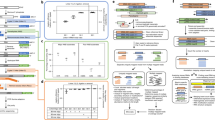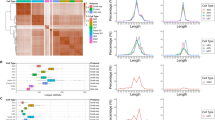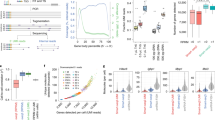Abstract
Small RNAs participate in several cellular processes, including splicing, RNA modification, mRNA degradation, and translational arrest. Traditional methods for sequencing small RNAs require a large amount of cell material, limiting the possibilities for single-cell analyses. We describe Small-seq, a ligation-based method that enables the capture, sequencing, and molecular counting of small RNAs from individual mammalian cells. Here, we provide a detailed protocol for this approach that relies on standard reagents and instruments. The standard protocol captures a complex set of small RNAs, including microRNAs (miRNAs), fragments of tRNAs and small nucleolar RNAs (snoRNAs); however, miRNAs can be enriched through the addition of a size-selection step. Ready-to-sequence libraries can be generated in 2–3 d, starting from cell collection, with additional days needed to computationally map the sequence reads and calculate molecular counts.
This is a preview of subscription content, access via your institution
Access options
Access Nature and 54 other Nature Portfolio journals
Get Nature+, our best-value online-access subscription
$29.99 / 30 days
cancel any time
Subscribe to this journal
Receive 12 print issues and online access
$259.00 per year
only $21.58 per issue
Buy this article
- Purchase on Springer Link
- Instant access to full article PDF
Prices may be subject to local taxes which are calculated during checkout



Similar content being viewed by others
References
Morris, K. V. & Mattick, J. S. The rise of regulatory RNA. Nat. Rev. Genet. 15, 423–437 (2014).
Vidigal, J. A. & Ventura, A. The biological functions of miRNAs: lessons from in vivo studies. Trends Cell Biol. 25, 137–147 (2015).
Guo, H., Ingolia, N. T., Weissman, J. S. & Bartel, D. P. Mammalian microRNAs predominantly act to decrease target mRNA levels. Nature 466, 835–840 (2010).
Wang, J., Chen, J. & Sen, S. MicroRNA as biomarkers and diagnostics. J. Cell. Physiol. 231, 25–30 (2016).
Kirchner, S. & Ignatova, Z. Emerging roles of tRNA in adaptive translation, signalling dynamics and disease. Nat. Rev. Genet. 16, 98–112 (2014).
Matera, A. G., Terns, R. M. & Terns, M. P. Non-coding RNAs: lessons from the small nuclear and small nucleolar RNAs. Nat. Rev. Mol. Cell Biol. 8, 209–220 (2007).
Schimmel, P. The emerging complexity of the tRNA world: mammalian tRNAs beyond protein synthesis. Nat. Rev. Mol. Cell Biol. 19, 45–58 (2017).
Dupuis-Sandoval, F., Poirier, M. & Scott, M. S. The emerging landscape of small nucleolar RNAs in cell biology. Wiley Interdiscip. Rev. RNA 6, 381–397 (2015).
Tang, F. et al. 220-plex microRNA expression profile of a single cell. Nat. Protoc. 1, 1154–1159 (2006).
White, A. K. et al. High-throughput microfluidic single-cell RT-qPCR. Proc. Natl. Acad. Sci. USA 108, 13999–14004 (2011).
Faridani, O. R. et al. Single-cell sequencing of the small-RNA transcriptome. Nat. Biotechnol. 34, 1264–1266 (2016).
Landgraf, P. et al. A mammalian microRNA expression atlas based on small RNA library sequencing. Cell 129, 1401–1414 (2007).
Hafner, M. et al. RNA-ligase-dependent biases in miRNA representation in deep-sequenced small RNA cDNA libraries. RNA 17, 1697–1712 (2011).
Munafó, D. B. & Robb, G. B. Optimization of enzymatic reaction conditions for generating representative pools of cDNA from small RNA. RNA 16, 2537–2552 (2010).
Little, J. W. Lambda exonuclease. Gene Amplif. Anal. 2, 135–145 (1981).
Dobin, A. et al. STAR: ultrafast universal RNA-seq aligner. Bioinformatics 29, 15–21 (2013).
Burroughs, A. M. et al. A comprehensive survey of 3ʹ animal miRNA modification events and a possible role for 3’ adenylation in modulating miRNA targeting effectiveness. Genome Res. 20, 1398–1410 (2010).
Smith, T., Heger, A. & Sudbery, I. UMI-tools: modeling sequencing errors in Unique Molecular Identifiers to improve quantification accuracy. Genome Res. 27, 491–499 (2017).
Parekh, S., Ziegenhain, C., Vieth, B., Enard, W. & Hellmann, I. zUMIs - a fast and flexible pipeline to process RNA sequencing data with UMIs. Gigascience 7, giy059 (2018).
Kozomara, A. & Griffiths-Jones, S. miRBase: annotating high confidence microRNAs using deep sequencing data. Nucleic Acids Res. 42, D68–D73 (2014).
Chan, P. P. & Lowe, T. M. GtRNAdb: a database of transfer RNA genes detected in genomic sequence. Nucleic Acids Res. 37, D93–D97 (2009).
Harrow, J. et al. GENCODE: the reference human genome annotation for The ENCODE Project. Genome Res. 22, 1760–1774 (2012).
Phelan, M. C. Basic techniques for mammalian cell tissue culture. Curr. Protoc. Cell Biol. 00, 1.1.1–1.1.10 (1998).
Acknowledgements
We thank B. Pannagel at the CMB FACS facility at Karolinska Institutet for performing the single-cell sorting. This research was supported by grants from the Swedish Research Council (grant no. 2017-01062 to R.S.) and the Bert L. & N. Kuggie Vallee Foundation (to R.S.).
Author information
Authors and Affiliations
Contributions
M.H.-J. developed and optimized the protocol, analyzed the data, and prepared the manuscript. I.A. constructed the bioinformatics pipeline, analyzed the data, and prepared the manuscript. R.S. supervised the development of the computational analyses and prepared the manuscript. O.R.F. conceived the study, developed the method, interpreted the results, and prepared the manuscript.
Corresponding author
Ethics declarations
Competing interests
O.R.F. and R.S. have filed a patent application (PCT/US2017/037620) on the protocol for single-cell small-RNA sequencing. The remaining authors declare no competing interests.
Additional information
Publisher’s note: Springer Nature remains neutral with regard to jurisdictional claims in published maps and institutional affiliations.
Related links
Key reference using this protocol
1. Faridani, O. R. et al. Nat. Biotechnol. 34, 1264–1266 (2016): https://doi.org/10.1038/nbt.3701
Integrated supplementary information
Supplementary Figure 1 Number of genes and molecules in a test example.
Number of captured small RNA–encoding genes (a) and small RNA molecules (b) in libraries containing the rRNA-masking oligonucleotide with HEK cells or without cells.
Supplementary Figure 2 Outline of the gating strategy implemented for sorting HEK293FT single cells.
Gates for selecting single cells are shown in plots for Side Scatter Area (SSC-A, logarithmic) against Forward Scatter Area (FSC-A) (a), Forward Scatter Width (FSC-W) against Forward Scatter Area (FSC-A) (b), and Side Scatter Width (SSC-W) against Side Scatter Area (SSC-A, logarithmic) (c). Propidium iodide was applied to stain for dead cells (d).
Supplementary Figure 3 Percentage of filtered and genome-mapped reads.
Libraries obtained from HEK cells or no cells (all with the rRNA-masking oligonucleotide) were generated and sequenced. Here, the percentages are shown for sequenced reads that are filtered (grey), cannot be mapped (green), are mapped to multiple loci (blue), and are uniquely mapped (purple).
Supplementary information
Supplementary Text and Figures
Supplementary Figures 1–3 and Supplementary Table 1
Rights and permissions
About this article
Cite this article
Hagemann-Jensen, M., Abdullayev, I., Sandberg, R. et al. Small-seq for single-cell small-RNA sequencing. Nat Protoc 13, 2407–2424 (2018). https://doi.org/10.1038/s41596-018-0049-y
Published:
Issue Date:
DOI: https://doi.org/10.1038/s41596-018-0049-y
This article is cited by
-
Small RNA transcriptome analysis using parallel single-cell small RNA sequencing
Scientific Reports (2023)
-
Non-coding RNAs in human health and disease: potential function as biomarkers and therapeutic targets
Functional & Integrative Genomics (2023)
-
Differential microRNA profiles in elderly males with seborrheic dermatitis
Scientific Reports (2022)
-
Computational approaches and challenges for identification and annotation of non-coding RNAs using RNA-Seq
Functional & Integrative Genomics (2022)
-
Small RNA sequencing reveals distinct nuclear microRNAs in pig granulosa cells during ovarian follicle growth
Journal of Ovarian Research (2021)
Comments
By submitting a comment you agree to abide by our Terms and Community Guidelines. If you find something abusive or that does not comply with our terms or guidelines please flag it as inappropriate.



